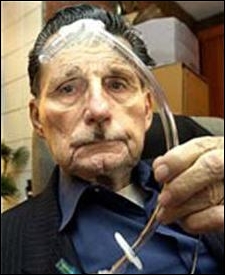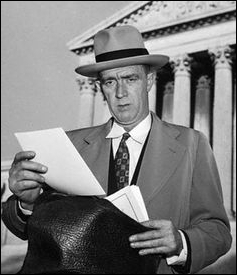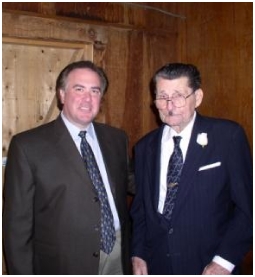A Man of Many Patents
Andrew Toti
SPEECH OF HON. DENNIS A. CARDOZA OF CALIFORNIA IN THE HOUSE OF REPRESENTATIVES
TUESDAY, FEBRUARY 10, 2004
Mr. CARDOZA. Mr. Speaker, I rise today to honor a great American inventor from Modesto, California, Mr. Andrew Toti. Mr. Toti has invented a number of household items, and has over 200 United States and foreign patents to his credit. He is a perfect example of the ``can-do'' attitude that Americans possess. His ingenuity has created the vertical blinds which many of us have in our office windows, to a device that helped save lives in World War II.
In a 1995 interview with Parade magazine, Mr. Toti stated that the most important element to successful inventing is defining a need for a new product or identifying a problem, then finding an elegant solution. Mr. Toti has been finding solutions to problems, and inventing new products almost his entire life. He credits his parents for nurturing and supporting his craft, and giving him advice on how to become a success.
At the young age of twelve, Mr. Toti created a new kind of combination lock, however it was not marketed very well. He learned quickly from this mistake. Mr. Toti has always been able to admit to mistakes, and this is one of his greatest qualities. When Mr. Toti was sixteen, he had built a boat with a very powerful motor. His mother was worried he would drown, so he began making a life vest using duck and goose feathers. He noticed that these vests were a bit bulky, so began filling them with compressed air. The War Department was told of his invention, and paid Mr. Toti $1500 for the rights. This life saving device soon became the Mae West life vest. This is the same life vest that President George H.W. Bush was wearing when he was shot down over the Pacific Ocean. Without this life preserver, President Bush might not have survived his ordeal in the ocean.
As you know Mr. Speaker, the San Joaquin Central Valley is a lush agricultural area, and our farmers grow anything from peaches to wine grapes, and raise cattle and poultry. Mr. Toti's ingenuity has helped two major industries in the area. First, in 1951, Mr. Toti patented his feather-plucking machine. This machine uses thousands of rubber "fingers'' to remove the feathers of poultry. Twenty-one years later, he assisted in designing a grape-harvesting machine for Ernest and Julio Gallo, two of the most prominent viticulturalists in the nation. Recently, Mr. Toti developed an endotracheal tube, which aids physicians with rapid intubation of the trachea in situations where the tube needs to bend due to anatomical variations in the body.
I ask all of my colleagues today to help me recognize and thank Mr. Toti for his contributions to our nation. It is my honor to represent such a fine constituent in the House of Representatives.
Remembering Andrew Toti: Andrew Toti, 89, Dies; Mae West Life Vest Among 500 Inventions
Toti's obiturary in the Washington Post begins, "Andrew Toti, 89, whose many inventions included an automated chicken plucker and a pop-top beer can and who was credited with inventing the Mae West flotation device, died March 27 at his rural Modesto, Calif., home. He suffered a fall a few months ago and never fully recovered." The obituary also notes that he was a "prolific inventor inspired by everyday needs he encountered in the world around him." Toti held patents on 500 or so inventions, which included an endo-tracheal breathing tube used worldwide during surgeries. It was when he was 16 that he invented the Mae West, according to the obituary. His mother was the impetus after he bought a boat. She was afraid he would fall out and drown. "To reassure her, he started tinkering with ideas for life preservers."
As Mr. Toti recalled in interviews over the years, he was 16 when he invented the Mae West. The impetus came from his mother, who was afraid he would fall out of a boat he recently had acquired and drown. To reassure her, he started tinkering with ideas for life preservers. Here is the account he shared about the invention:
Young Mr. Toti's invention was a breakthrough. It consisted of two pneumatic compartments of rubber-coated yellow fabric that could be inflated separately by blowing into a tube or pulling cords that released carbon dioxide. Waist and crotch straps kept the vest in place.The War Department paid him $1,600 for his invention in 1936; he used the money to buy a new house in Modesto. GIs dubbed the device the Mae West, after the buxom burlesque and film star whom wearers of the vest resembled.
Thousand of sailors and airmen during World War II owed their lives to their trusty Mae West, including a young Navy pilot, Lt. j.g. George H. W. Bush. Shot down over the Pacific on Sept. 2, 1944, the future president managed to stay afloat until he was spotted by passing planes and then rescued by a submarine. "Please tell [your father] a grateful Navy man who benefited from his invention sends his best wishes," he said in a message to Mr. Toti's daughter at a ceremony in the inventor's honor last fall.
Mae West flotation devices are carried to this day on all commercial aircraft.
Mr. Toti was born in Visalia in California's agricultural Central Valley. The son of Italian immigrant farmers, he moved to Modesto at 9 when his parents bought a delicatessen and chicken farm.
That same year, he came up with his first invention, a version of the combination lock. He dropped out of Modesto High School after the 10th grade and finished by attending night school and taking correspondence courses in drafting and mechanical engineering.
Link: NPR Audio
Link: Wikipedia Entry
Next: People/Ann Veneman
Previous: People/Jeremy Renner

|
|
|


